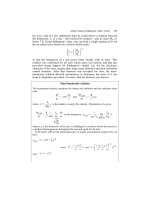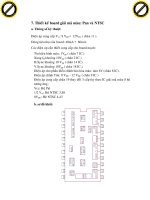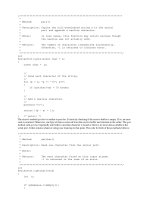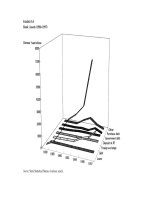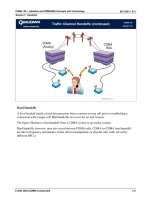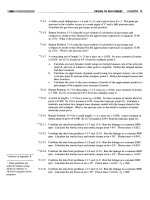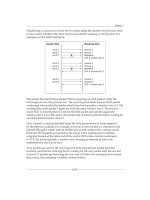Designing and Implementing Linux Firewalls and QoS using netfilter, iproute2, NAT, and filter phần 8 pps
Bạn đang xem bản rút gọn của tài liệu. Xem và tải ngay bản đầy đủ của tài liệu tại đây (1.3 MB, 29 trang )
Chapter 7
[ 191 ]
#Remote DB application developers
#we allow a minimum of 1/8 of total bandwidth for remote developers
let RBW=$BW/8
$AC 1:1 classid 1:30 htb rate ${RBW}kbit ceil ${RBW}kbit prio 2
$AQ 1:30 handle 300: pfifo limit 5
$AF handle 3 fw classid 1:30
#traffic between HQ and this location
#we allow a minimum of 1/4 of total bandwidth for traffic with HQ
let I=$BW/4
$AC 1:1 classid 1:40 htb rate ${I}kbit ceil ${BW}kbit prio 3
$AQ 1:40 handle 400: pfifo limit 5
$AF handle 4 fw classid 1:40
#Internet Traffic for users
#we allow a minimum of 1/4 of total bandwidth for internet traffic
$AC 1:1 classid 1:50 htb rate ${I}kbit ceil ${BW}kbit prio 4
$AQ 1:50 handle 500: pfifo limit 5
tc filter add dev eth0 protocol ip parent 1:0 prio 5 u32 match ip src
$PREFIX.0/24 flowid 1:50
This is the basic setup for QoS. More information about HTB can be found at
Example 2: A Typical Small ISP
The term "typical" might not be so appropriate when talking about small ISPs. We
have met a lot of network administrators and we seen a lot of small ISPs, and they all
had different congurations.
The network we are going to build in this example is not specic to any provider
but rather a general one. These types of networks exist in generally with a few
modications.
The network has more security breakpoints than the previous network; so we'll have
more complex and complicated rewalls.
Medium Networks Case Studies
[ 192 ]
The Network
Let's take the following network as an example:
This is a small ISP that has one internet connection, an access network, a server farm,
and the internal departments. This ISP uses Linux routers and servers.
The connection from the provider comes in one interface of the Linux core router.
Usually, the core router should be a very stable and powerful machine because it
needs to have a few network interfaces through which a signicant amount of data
is passed.
Chapter 7
[ 193 ]
Depending on how powerful the core router is, we can say how many users the
network can accommodate. A dual Xeon can handle easily a few hundred broadband
customers and over one thousand smaller customers. You can never say "OK, this
network is t for 2000 customers", because it really depends on what kind of trafc
they make or what kind of services you provide.
The intranet server is a Linux server used for intranet applications and is also used
to perform routing and NAT for the internal departments. The intranet server is also
responsible with the rewall for the internal departments.
There is a part of the network named the server farm, which contains the servers
of the ISP. There is a database server, an email server, a web server that also
does web hosting and a radius server used for authorization and accounting
(AAA—Authentication, Authorization, and Accounting server) which also runs
DNS server software. Each of these servers runs Linux as OS, and has a dedicated
interface in the core router, which means that all packets arriving in this part of the
network pass through the core router.
The most complicated part is the access network. When building it, you have to
consider the available physical bandwidth for each connection. You can see on the
diagram a server called "Wireless Server". Normally, instead of a computer there,
we can use a wireless bridge. However, the wireless bridge would be connected to
an access point far away in a wireless network that doesn't support very high data
rates and a large number of packets per second. High trafc between users in the
metro Ethernet and wireless users or a large number of broadcasts from the metro
Ethernet network would affect the wireless network performance, because a wireless
bridge would place the wireless network in the same broadcast domain as the metro
Ethernet network, and we wouldn't be able to do anything since packets would only
go through the switch. Of course this can be avoided by breaking up the network
using multiple VLANs.
What we want to do is ease the core router's job and place a wireless server so that
we can perform QoS for the long range wireless customers without having all the
access trafc (between metro Ethernet and wireless) going through the core router.
In the close wireless user case, we won't do this. The close wireless users can connect
to the access point, which is a bridge to very high data rates; so we are not in the
situation where we need to limit all Metro Ethernet access to this network.
In the access part of the network, there is an access server that is used for
providing dial-up access. The access server "talks" AAA with the radius server in
the server farm.
Medium Networks Case Studies
[ 194 ]
Building the Network Conguration
For the internet connection, the provider assigned one public IP address (1.1.1.1). The
ISP has one class C network 1.2.3.0/24 that must be divided in subnets to be able to
provide public IP addresses to all these segments of the network.
The way I would subnet this class would be like this:
1.2.3.0/29 subnet for the servers. I would allocate 1.2.3.1 to the radius server,
which also runs a DNS server. The core router would have an interface
(eth1) with the IP address 1.2.3.6 and netmask 255.255.255.248 connected to
the server farm switch.
The intranet server has a separate interface (eth2) which needs a /30 subnet.
I would allocate the IP address 1.2.3.9/30 (netmask 255.255.255.252) for the
core router and 1.2.3.10/30 for the intranet server. The technical department
needs public IP addresses; so I'll route the subnet 1.2.3.16/29 through
the intranet server. The intranet server runs OpenVPN for the network
administrators to connect from remote locations. We'll route the subnet
1.2.3.24/29 to the intranet server for the interfaces on OpenVPN.
I would allocate for the access network the subnet 1.2.3.128/25 from which I
would allocate 1.2.3.129 for eth3 on the core router, 1.2.3.130 for eth0 on the
wireless server, and 1.2.3.131 for the dial-up access server.
There are devices in the network (switches, wireless access points) that
can be managed via telnet/web/snmp. These devices don't need public
IP addresses, and we don't need to NAT them; so I bring up on the core
router an alias to eth3 (eth3:1) with the IP address 192.168.100.1 netmask
255.255.255.0, and set up all those devices to use IP addresses from
192.168.100.0/24.
I would then route the subnet 1.2.3.32/27 to the long range wireless users
and set 1.2.3.33 on the wlan0 wireless interface.
There are two E1 connections for dial-up access (60 lines in total) that can be
used for analog dial-up or ISDN dial-up services. For that I would allocate
the subnet 1.2.3.64/26 with a PPP pool starting from 1.2.3.65 up to 1.2.3.126.
•
•
•
•
•
•
Chapter 7
[ 195 ]
After subnetting, the network looks like this:
This is the network for which we will build the rewalls.
Designing and Implementing the Firewalls
Due to the fact that all the servers run Linux, they will all have their own rewall.
However, the main rewall is on the core router, and so we'll have double protection
and can say that we have a layered defense here. Layered defense is when we have
machines and services protected by more than one rewall placed one behind the
other, so that if the outer one fails, we still have protection.
Medium Networks Case Studies
[ 196 ]
The reason the intranet server exists in this network is not only for running
the intranet application, but also for NATing the local network of the internal
departments. If the core router did that instead of having the intranet server there,
we would have to use the ip_conntrack module on the core router, which is not
recommended, because at high PPS (packets per second) rates, the conntrack table
would ll and drop packets.
We will build the rewall policy for each server along with the scripts.
The Intranet Server: 1.2.3.10
The intranet server runs the intranet application, which is written in PHP. It only
needs to connect to the database, which has the IP address 1.2.3.2, on port 5432/
TCP (PostgreSQL). It is also a le server running Samba and OpenVPN for the
administrators to connect to this server from home.
We leave SSH to run on the default port (22/TCP), Apache web server on 80/TCP,
and we set up OpenVPN to listen on port 6669/TCP.
We should check to see if there are other ports opened, using netstat:
intranet:~# netstat -an
Active Internet connections (servers and established)
Proto Recv-Q Send-Q Local Address Foreign Address State
tcp 0 0 0.0.0.0:139 0.0.0.0:* LISTEN
tcp 0 0 0.0.0.0:6669 0.0.0.0:* LISTEN
tcp 0 0 0.0.0.0:80 0.0.0.0:* LISTEN
tcp 0 0 0.0.0.0:22 0.0.0.0:* LISTEN
tcp 0 0 0.0.0.0:445 0.0.0.0:* LISTEN
udp 0 0 0.0.0.0:137 0.0.0.0:*
udp 0 0 0.0.0.0:138 0.0.0.0:*
This looks normal; so we'll set up the lters in the INPUT chain to secure our server.
The rst thing we want to do is set the INPUT policy to DROP so that all packets with
the destination one of the intranet server's IP addresses will be dropped unless they
match one of the ALLOW rules in the chain. We don't want to lter anything on the
loopback interface.
iptables -P INPUT DROP
iptables -A INPUT -i lo -j ACCEPT
We don't want to lter any ICMP messages:
iptables -A INPUT -p icmp -j ACCEPT
Chapter 7
[ 197 ]
Next, we want to allow our internal departments access to the web server running
the intranet application:
iptables -A INPUT -s 192.168.1.0/24 -p tcp dport 80 -j ACCEPT
iptables -A INPUT -s 1.2.3.16/28 -p tcp dport 80 -j ACCEPT
The second line allows 1.2.3.16/28, which contains both subnets 1.2.3.16/29 (the
technical department) and 1.2.3.24/29 (IP addresses for VPN connections).
We want to allow everyone to connect to OpenVPN. The authentication for
OpenVPN is made using SSL certicates; so, we want to allow the network
administrators with their certicates on their laptop computers or on a USB ash to
connect from anywhere:
iptables -A INPUT -p tcp dport 6669 -j ACCEPT
Only the network administrators should have SSH access on the intranet server:
iptables -A INPUT -s 1.2.3.16/28 -p tcp dport 22 -j ACCEPT
All the internal departments must have access to the le server:
iptables -A INPUT -s 192.168.1.0/24 -p tcp dport 137:139 -j ACCEPT
iptables -A INPUT -s 192.168.1.0/24 -p udp dport 137:139 -j ACCEPT
iptables -A INPUT -s 192.168.1.0/24 -p tcp dport 445 -j ACCEPT
iptables -A INPUT -s 1.2.3.16/28 -p tcp dport 137:139 -j ACCEPT
iptables -A INPUT -s 1.2.3.16/28 -p udp dport 137:139 -j ACCEPT
iptables -A INPUT -s 1.2.3.16/28 -p tcp dport 445 -j ACCEPT
We want to allow the intranet server to resolve hostnames so we will allow
DNS packets:
iptables -A INPUT -p udp sport 53 -j ACCEPT
We also want to allow the intranet server to be able to initiate TCP connections (for
web access, FTP, etc.):
iptables -A INPUT -p tcp ! syn -j ACCEPT
This also allows the intranet server to connect to the database at 1.2.3.2.
The FORWARD chain must have the default policy ALLOW. We'll just lter the NetBIOS
and ms-ds packets that come in on eth0, which is the "external" interface:
iptables -A FORWARD -i eth0 -p tcp dport 137:139 -j DROP
iptables -A FORWARD -i eth0 -p udp dport 137:139 -j DROP
iptables -A FORWARD -i eth0 -p tcp dport 445 -j DROP
Medium Networks Case Studies
[ 198 ]
All we need to do further with the intranet server is to NAT the 192.168.1.0/24
network:
iptables -t nat -A POSTROUTING -s 192.168.1.0/24 -o eth0 -j MASQUERADE
We MASQUERADE all packets from 192.168.1.0/24 except to 1.2.3.16/28 to allow
NetBIOS and remote desktop trafc between the network administrators and the rest
of the internal departments.
Putting all those rules in a script that is usually executed at boot time would result in:
#!/bin/bash
IPT="/sbin/iptables"
#flush rules
$IPT -F
########## INPUT Chain ########
#policy Drop
$IPT -P INPUT DROP
#Accept all on the loopback interface
$IPT -A INPUT -i lo -j ACCEPT
#Accept icmp
$IPT -A INPUT -p icmp -j ACCEPT
#Allow internal departments to local web server
$IPT -A INPUT -s 192.168.1.0/24 -p tcp dport 80 -j ACCEPT
$IPT -A INPUT -s 1.2.3.16/28 -p tcp dport 80 -j ACCEPT
#Allow users to connect to openvpn
$IPT -A INPUT -p tcp dport 6669 -j ACCEPT
#Allow admins SSH access
$IPT -A INPUT -s 1.2.3.16/28 -p tcp dport 22 -j ACCEPT
#Allow internal departments SAMBA connections
$IPT -A INPUT -s 192.168.1.0/24 -p tcp dport 137:139 -j ACCEPT
$IPT -A INPUT -s 192.168.1.0/24 -p udp dport 137:139 -j ACCEPT
$IPT -A INPUT -s 192.168.1.0/24 -p tcp dport 445 -j ACCEPT
#Allow admins SAMBA connections
$IPT -A INPUT -s 1.2.3.16/28 -p tcp dport 137:139 -j ACCEPT
Chapter 7
[ 199 ]
$IPT -A INPUT -s 1.2.3.16/28 -p udp dport 137:139 -j ACCEPT
$IPT -A INPUT -s 1.2.3.16/28 -p tcp dport 445 -j ACCEPT
#Allow the intranet server to receive DNS packets
$IPT -A INPUT -p udp sport 53 -j ACCEPT
#Allow non syn packets (connections initiated by this machine)
$IPT -A INPUT -p tcp ! syn -j ACCEPT
########## FORWARD Chain ########
#Drop SAMBA and ms-ds comming in eth0
$IPT -A FORWARD -i eth0 -p tcp dport 137:139 -j DROP
$IPT -A FORWARD -i eth0 -p udp dport 137:139 -j DROP
$IPT -A FORWARD -i eth0 -p tcp dport 445 -j DROP
########## NAT table ########
#Flush Nat Rules
$IPT -t nat -F
#load some modules for nat to work better
/sbin/modprobe ip_nat_ftp
/sbin/modprobe ip_nat_irc
#MASQ internal departments
$IPT -t nat -A POSTROUTING -s 192.168.1.0/24 -o eth0 -j MASQUERADE
To verify the conguration, we should use iptables –L –n and iptables –t nat –L –n.
intranet:~# iptables -L –n
Chain INPUT (policy DROP)
ACCEPT icmp 0.0.0.0/0 0.0.0.0/0
ACCEPT tcp 192.168.1.0/24 0.0.0.0/0 tcp dpt:80
ACCEPT tcp 1.2.3.16/28 0.0.0.0/0 tcp dpt:80
ACCEPT tcp 0.0.0.0/0 0.0.0.0/0 tcp dpt:6669
ACCEPT tcp 1.2.3.16/28 0.0.0.0/0 tcp dpt:22
ACCEPT tcp 192.168.1.0/24 0.0.0.0/0 tcp dpts:137:139
ACCEPT udp 192.168.1.0/24 0.0.0.0/0 udp dpts:137:139
ACCEPT tcp 192.168.1.0/24 0.0.0.0/0 tcp dpt:445
ACCEPT tcp 1.2.3.16/28 0.0.0.0/0 tcp dpts:137:139
ACCEPT udp 1.2.3.16/28 0.0.0.0/0 udp dpts:137:139
ACCEPT tcp 1.2.3.16/28 0.0.0.0/0 tcp dpt:445
ACCEPT udp 0.0.0.0/0 0.0.0.0/0 udp spt:53
ACCEPT tcp 0.0.0.0/0 0.0.0.0/0 tcp flags:!0x16/0x02
Chain FORWARD (policy ACCEPT)
Medium Networks Case Studies
[ 200 ]
target prot opt source destination
ACCEPT all 0.0.0.0/0 0.0.0.0/0
DROP tcp 0.0.0.0/0 0.0.0.0/0 tcp dpts:137:139
DROP udp 0.0.0.0/0 0.0.0.0/0 udp dpts:137:139
DROP tcp 0.0.0.0/0 0.0.0.0/0 tcp dpt:445
Chain OUTPUT (policy ACCEPT)
target prot opt source destination
intranet:~#
intranet:~# iptables -t nat -L -n
Chain PREROUTING (policy ACCEPT)
target prot opt source destination
Chain POSTROUTING (policy ACCEPT)
target prot opt source destination
MASQUERADE all 192.168.1.0/24 !1.2.3.16/28
Chain OUTPUT (policy ACCEPT)
target prot opt source destination
Everything looks OK, and if everything works OK for the internal departments, then
it means we did a good job. More than that, we built a very restrictive rewall; so we
should be safe with the intranet server.
The Wireless Server: 1.2.3.130
The wireless server is more like a router. It doesn't need much of a rewall, and it
doesn't perform NAT for anyone. Its basic function is to route the subnet 1.2.3.33/27
on its wireless interface and to perform QoS for the wireless users connected to it. It
only needs to run SSH; so we'll build a rewall like this:
#!/bin/bash
IPT="/sbin/iptables"
#flush rules
$IPT -F
########## INPUT Chain ########
#policy Drop
$IPT -P INPUT DROP
#Accept all on the loopback interface
$IPT -A INPUT -i lo -j ACCEPT
Chapter 7
[ 201 ]
#Accept icmp
$IPT -A INPUT -p icmp -j ACCEPT
#Allow admins SSH access
$IPT -A INPUT -s 1.2.3.16/28 -p tcp dport 22 -j ACCEPT
#Allow the wireless server to receive DNS packets
$IPT -A INPUT -p udp sport 53 -j ACCEPT
#Allow non syn packets (connections initiated by this machine)
$IPT -A INPUT -p tcp ! syn -j ACCEPT
So, what we did for this server was to set the policy for the INPUT chain to DROP.
Then we allowed ICMP messages, SSH for the network administrators, and also let it
access the Internet (for updates, etc.).
The AAA Server: 1.2.3.1
The AAA server runs radius for Authentication, Authorization, and Accounting for
dial-up users, and also for the email users who are stored in the database at 1.2.3.2.
It also runs a DNS server. As we learned in the previous chapters, DNS is a service
exposed to attacks, and bugs often appear in different DNS server implementations.
The worst thing about DNS servers is that we can't lter their trafc because they
wouldn't function anymore.
The most popular DNS server is BIND, which is one of the programs with a very
high number of remotely exploitable bugs compromising security.
My advice is to use other DNS servers than BIND (e.g. djbdns, at http://tinydns.
org/). However, if you decide on using BIND, please don't use any precompiled
executables or installation packages. If you use BIND, you must download the latest
version of BIND from and place it in a chroot
jail. Please read the chroot-BIND HowTo found at />Chroot-BIND-HOWTO.html.
We will use the FreeRADIUS server for AAA with database support. FreeRADIUS
also had some security issues in the past, but we can solve that by creating an
appropriate rewall for it. However, it is recommended that you run FreeRADIUS in
a chroot jail too.
So, we must have SSH, DNS, and Radius running on this server:
AAA:~# netstat -an
Active Internet connections (servers and established)
Proto Recv-Q Send-Q Local Address Foreign Address State
Medium Networks Case Studies
[ 202 ]
tcp 0 0 0.0.0.0:22 0.0.0.0:* LISTEN
tcp 0 0 0.0.0.0:53 0.0.0.0:* LISTEN
udp 0 0 0.0.0.0:53 0.0.0.0:*
udp 0 0 0.0.0.0:1812 0.0.0.0:*
udp 0 0 0.0.0.0:1813 0.0.0.0:*
udp 0 0 0.0.0.0:1814 0.0.0.0:*
We will leave the INPUT chain policy as ACCEPT. First, we need to lter SSH to drop
all TCP packets arriving on port 22 except from 1.2.3.16/28:
iptables -A INPUT -s ! 1.2.3.16/28 -p tcp dport 22 -j DROP
For radius packets, we will create a chain called RADIUS and add a rewall rule in the
INPUT chain to forward all packets on ports 1812-1814 UDP to the RADIUS chain:
iptables -N RADIUS
iptables -A INPUT -p udp dport 1812:1814 -j RADIUS
Next, we want to allow Radius access to the access server, the mail server, and the
Radius server itself. So we'll add the following rules to the RADIUS chain:
iptables -A RADIUS -i lo -j ACCEPT
iptables -A RADIUS -s 1.2.3.131 -j ACCEPT
iptables -A RADIUS -s 1.2.3.3 -j ACCEPT
Now we just need to drop Radius packets arriving from other hosts:
iptables -A RADIUS -j DROP
Using the netstat command, we see that our server
listens on port 53/TCP. This is used by the DNS server for
zone transfer. Since we don't have a secondary DNS server,
we might disable that or just lter it.
We will leave UDP trafc untouched, but since we don't need to receive any
TCP connections to this server, and only initiate TCP connections, we'll drop
SYN packets:
iptables -A INPUT -i ! lo -p tcp syn -j DROP
Putting it up together, the script should look like this:
#!/bin/bash
IPT="/sbin/iptables"
Chapter 7
[ 203 ]
#flush rules
$IPT -F
#Drop SSH packets except from admins
$IPT -A INPUT -s ! 1.2.3.16/28 -p tcp dport 22 -j DROP
#Create the RADIUS Chain
$IPT -N RADIUS
#All incoming radius packets jump to RADIUS chain
$IPT -A INPUT -p udp dport 1812:1814 -j RADIUS
#Allow some hosts to the RADIUS chain
$IPT -A RADIUS -i lo -j ACCEPT
$IPT -A RADIUS -s 1.2.3.131 -j ACCEPT
$IPT -A RADIUS -s 1.2.3.3 -j ACCEPT
#Drop everything else in the RADIUS chain
$IPT -A RADIUS -j DROP
#Drop incoming TCP SYN packets except on loopback
$IPT -A INPUT -i ! lo -p tcp syn -j DROP
The Database Server: 1.2.3.2
The database server is the most important servers because it holds the database with
all customer details and the business operations from the intranet application.
It is very important for us to secure the database server, and this is not even very
difcult. Although we can combine the other three servers in two or even one server
that can run Radius, DNS, web, FTP, and email, this ISP should keep the database
on a separate machine. They can all be on the same machine, but it's strongly
recommended that the database be on a different machine, as DNS, web, FTP, email,
and even Radius are open to remote exploits.
We stated that it's not very difcult to secure the database server. Assuming we run
PostgreSQL on the default port 5432, we have only a few steps to be taken. First, we
want to set the INPUT chain policy to DROP:
iptables -P INPUT DROP
Next, we want to allow packets on the loopback interface:
iptables -A INPUT -i lo -j ACCEPT
Medium Networks Case Studies
[ 204 ]
We will accept incoming SSH connections from the network administrators:
iptables -A INPUT -s 1.2.3.16/28 -p tcp dport 22 -j ACCEPT
Next, we need to create a chain named SQL and pass all packets arriving with the
destination port 5432/TCP to this chain:
iptables -N SQL
iptables -A INPUT -p udp dport 5432 -j SQL
In the SQL chain we need to allow packets from the Radius server and from the
intranet server:
iptables -A SQL -s 1.2.3.1 -j ACCEPT
iptables -A SQL -s 1.2.3.10 -j ACCEPT
iptables -A SQL -j DROP
We want to give access to the SQL server to the Internet for updates. We will allow
DNS packets and TCP packets except SYN. To be more restrictive, we can allow DNS
packets only from our DNS server.
iptables -A INPUT -s 1.2.3.1 -p udp sport 53 -j ACCEPT
iptables -A INPUT -p tcp ! syn -j ACCEPT
Now, let's set the script for the database server:
#!/bin/bash
IPT="/sbin/iptables"
#flush rules
$IPT -F
#INPUT chain policy DROP
$IPT -P INPUT DROP
#Accept packets on loopback
$IPT -A INPUT -i lo -j ACCEPT
#Accept SSH from Admins
$IPT -A INPUT -s 1.2.3.16/28 -p tcp dport 22 -j ACCEPT
#Create SQL chain and jump packets for 5432/tcp to it
$IPT -N SQL
$IPT -A INPUT -p udp dport 5432 -j SQL
#Allow SQL connections from AAA and intranet servers
Chapter 7
[ 205 ]
$IPT -A SQL -s 1.2.3.1 -j ACCEPT
$IPT -A SQL -s 1.2.3.10 -j ACCEPT
$IPT -A SQL -j DROP
#Allow outgoing TCP connections
$IPT -A INPUT -s 1.2.3.1 -p udp sport 53 -j ACCEPT
$IPT -A INPUT -p tcp ! syn -j ACCEPT
The Email Server: 1.2.3.3
Sendmail is the most popular SMTP server. Sendmail had some security issues in the
past, and it's very probable for it to have such issues in the future. For this server, we
have rewalls similar to the others. The SMTP server running on port 25 must not
be ltered, because then it would not be able to receive emails anymore. chrooting
Sendmail is not a good idea because most probably you won't be able to receive mail.
Therefore you can either choose another SMTP server (I would recommend Postx)
or have your Sendmail server up to date all the time.
Running the xinetd POP3 server is a good idea and it has been pretty stable over
the years. There is no reason to lter POP3 unless you don't want to allow users to
get their email from other locations than within the ISP network. Some may call it
paranoia, but there's a good reason for why others do this—POP3 is unencrypted,
and it's is very easy to sniff POP3 passwords, and so, getting your email from outside
your ISP network might bring some risks for your email account. We can also
encrypt POP3 (e.g. on Debian Linux package courier-pop-ssl) to eliminate this
concern.
Since the email server has a rewall somewhat similar to the others, we'll present the
script with the appropriate comments:
#!/bin/bash
IPT="/sbin/iptables"
#flush rules
$IPT -F
#INPUT chain policy DROP
$IPT -P INPUT DROP
#Accept packets on loopback
$IPT -A INPUT -i lo -j ACCEPT
#Accept SSH from Admins
Medium Networks Case Studies
[ 206 ]
$IPT -A INPUT -s 1.2.3.16/28 -p tcp dport 22 -j ACCEPT
#Accept UDP radius packets from the AAA server
$IPT -A INPUT -s 1.2.3.1 -p udp sport 1812:1814 -j ACCEPT
#Accept SMTP traffic
$IPT -A INPUT -p tcp dport 25 -j ACCEPT
#Accept POP3 traffic
$IPT -A INPUT -p tcp dport 110 -j ACCEPT
#Allow outgoing TCP connections
$IPT -A INPUT -s 1.2.3.1 -p udp sport 53 -j ACCEPT
$IPT -A INPUT -p tcp ! syn -j ACCEPT
Please note that once we set the INPUT chain policy to DROP, even if the mail server
initiates connections to the Radius server, if we don't specify the rule:
$IPT -A INPUT -s 1.2.3.1 -p udp sport 1812:1814 -j ACCEPT
those packets will be dropped because Radius uses UDP packets and not TCP. As
we learned in Chapter 3, UDP is not connection-oriented; there is no SYN ACK
handshake, and therefore we need this rule for Radius communication to work.
The Web Server: 1.2.3.4
The web server is running Apache with PHP and MySQL for web hosting. It also
runs an FTP server for users to upload their web pages.
We need to make sure that Apache and PHP are up to date and they are congured
in a secure manner so that people for whom we offer web-hosting solutions
can't gain unauthorized access. Please read carefully the instructions at
and
to secure the two products.
MySQL should be accessed on the loopback interface for security; so the server string
in each MySQL connection should be 127.0.0.1.
There are a lot of FTP servers that can be used, out of which we recommend ProFTPD
and Pure-FTPd. Also, we need to be sure that we have the latest version. Running an
FTP server on our host raises up a new problem we didn't encounter so far.
FTP is a different protocol from the others in the way that it uses a 'control' port and
a 'data' port. FTP runs only on TCP, and by standard, it uses port 21 (FTP) for control
(connecting and issuing commands to the server) and port 20 (FTP data) for actual
data transfer. However, FTP has two modes:
Chapter 7
[ 207 ]
Active mode: The client initiates the connection to the server on port 21 using
an unprivileged port N (N>1024). After the connection is established, the
client listens on port N+1 and sends the FTP server the command PORT N+1.
The FTP server will initiate a connection from port 20/TCP to the client on
port N+1/TCP for data transfer.
Passive mode: The client initiates the connection to the server on port 21
using an unprivileged port N like in the active mode. At this point, the FTP
server opens an unprivileged port Y (Y>1024) and sends to the client the
command "PORT Y". Then, the client will open a connection from its port N+1
to the FTP server's port Y.
To toggle between active/passive modes of FTP, a client must issue the command
PASV to the server.
In the rst case (active mode), at one point, the server is trying to initiate a TCP
connection from port 20 to an unprivileged port of the client. If the client is behind
NAT, there is a high chance that the connection won't work, and this is mainly why
passive mode is used.
Considering we offer web hosting on this server, we may think that we might
have a lot of clients behind NAT that want to access the FTP server. Both ProFTPD
and Pure-FTPd have conguration directives to specify what port range to use for
passive connections.
We should set the FTP passive port range to 50000-52000. Now, the rewall script
would look like this:
#!/bin/bash
IPT="/sbin/iptables"
#flush rules
$IPT -F
#INPUT chain policy DROP
$IPT -P INPUT DROP
#Accept packets on loopback
$IPT -A INPUT -i lo -j ACCEPT
#Accept SSH from Admins
$IPT -A INPUT -s 1.2.3.16/28 -p tcp dport 22 -j ACCEPT
#Accept FTP connections
$IPT -A INPUT -p tcp dport 21 -j ACCEPT
•
•
Medium Networks Case Studies
[ 208 ]
#Active connections initiate the requests
#So we only have to accept passive connections
$IPT -A INPUT -p tcp dport 50000:52000 -j ACCEPT
#Accept web connections
$IPT -A INPUT -p tcp dport 80 -j ACCEPT
#Allow outgoing TCP connections
$IPT -A INPUT -s 1.2.3.1 -p udp sport 53 -j ACCEPT
$IPT -A INPUT -p tcp ! syn -j ACCEPT
A Few Words on the Access Server: 1.2.3.131
While there are a lot of linecards that can be used on Linux to provide computers
with interfaces such as E1 or T1, it seems more feasible to use a dial-up access server
built by a telecom hardware supplier such as Cisco, Lucent, Alcatel, etc.
These access servers usually have a built-in web server and Telnet server for
conguration, and most of them support conguration via SNMP. Even if we have a
rewall on the core router, it would be good to be able to build a rewall on the access
server itself as the last line of defense against attackers as well as for the dial-up users.
If the access server is Cisco, then you can build an extended access list like this:
access-list 101 permit tcp 1.2.3.16 0.0.0.15 host 1.2.3.131 eq telnet
access-list 101 permit tcp 1.2.3.16 0.0.0.15 host 1.2.3.131 eq www
access-list 101 permit udp 1.2.3.16 0.0.0.15 host 1.2.3.131 eq snmp
access-list 101 permit icmp any host 1.2.3.131
access-list 101 deny ip any host 1.2.3.131
You can then apply the access list on the network interface (FastEthernet 0) and on
the dialer groups you created for dial-up users.
The Core Router—First Line of DefenseDefense
We left the core router to last for the simple reason that most of the rewall on the
core router contains pieces from the rewalls on the other servers.
Chapter 7
[ 209 ]
Now, let's refresh our memory with the network diagram:
From a security point of view, the core router is the rst line of defense. The rst line
of defense should stop all attacks coming from outside. However, if the rewall at
the core router fails, then the rewall on each server is responsible for the security of
that server.
If a user gains unauthorized access due to a bug in one of the services running on
one server, the core router rewall or the rewall on that server are useless. In this
case, the attacker has access to a server directly connected to the other servers in the
server farm, and so the rst line of defense has failed.
Medium Networks Case Studies
[ 210 ]
To get back to the reason we implemented security on the core router last, we think
it's better this way because we already explained a lot of features that will be use in
this rewall, and we did that by specifying the services for each situation.
The INPUT chain for the core router is the simplest of all the rewalls so far.
We need to set the policy to DROP, allow SSH, ICMP, and DNS, and disallow SYN
packets—that's all!
In the FORWARD chain, we will do most of the operations we already did on the
servers. Let's set up the script:
#!/bin/bash
IPT="/sbin/iptables"
#flush rules
$IPT -F
########## INPUT Chain begin ########
#policy Drop
$IPT -P INPUT DROP
#Accept all on the loopback interface
$IPT -A INPUT -i lo -j ACCEPT
#Accept icmp
$IPT -A INPUT -p icmp -j ACCEPT
#Allow admins SSH access
$IPT -A INPUT -s 1.2.3.16/28 -p tcp dport 22 -j ACCEPT
#Allow the core router to receive DNS packets
$IPT -A INPUT -p udp sport 53 -j ACCEPT
#Allow non syn packets (connections initiated by this machine)
$IPT -A INPUT -p tcp ! syn -j ACCEPT
########## INPUT Chain end ########
########## FORWARD Chain begin ########
########## policy ACCEPT - default
#Deny Access to switches and wireless equipment
$IPT -A FORWARD -s ! 1.2.3.16/28 -d 192.168.100.0/24 -j DROP
Chapter 7
[ 211 ]
#Allow SSH access to everything from admins
$IPT -A FORWARD -s ! 1.2.3.16/28 -p tcp dport 22 -j ACCEPT
#Allow established tcp packets out eth1 and eth2
$IPT -A FORWARD -o eth1 -p tcp ! syn -j ACCEPT
$IPT -A FORWARD -o eth2 -p tcp ! syn -j ACCEPT
#Create a chain for the intranet server
#Intranet server
$IPT -N INTRANET
$IPT -A FORWARD -d 1.2.3.10 -j INTRANET
###### INTRANET Chain
#DROP web packets for the intranet application
$IPT -A INTRANET -p tcp dport 80 -j DROP
#DROP SSH (Packets from ADMINS don't pass through here)
$IPT -A INTRANET -p tcp dport 22 -j DROP
#Drop Samba and ms-ds for packets on eth2
$IPT -A FORWARD -o eth2 -p tcp dport 137:139 -j DROP
$IPT -A FORWARD -o eth2 -p udp dport 137:139 -j DROP
$IPT -A FORWARD -o eth2 -p tcp dport 445 -j DROP
#wireless server - simple, we don't need a chain
$IPT -A FORWARD -d 1.2.3.130 -p udp sport 53 -j ACCEPT
$IPT -A FORWARD -d 1.2.3.130 -p ICMP -j ACCEPT
$IPT -A FORWARD -d 1.2.3.130 -j DROP
#AAA server
$IPT -A FORWARD -d 1.2.3.1 -s ! 1.2.3.131 -p udp dport 1812:1814 -j
DROP
$IPT -A FORWARD -d 1.2.3.1 -p tcp dport 23 -j DROP
#SQL server
$IPT -A FORWARD -d 1.2.3.2 -s ! 1.2.3.10 -p tcp dport 5432 -j DROP
$IPT -A FORWARD -d 1.2.3.2 -p ICMP -j ACCEPT
$IPT -A FORWARD -d 1.2.3.2 -j DROP
#MAIL server
$IPT -A FORWARD -d 1.2.3.3 -p tcp dport 25 -j ACCEPT
$IPT -A FORWARD -d 1.2.3.3 -p tcp dport 110 -j ACCEPT
$IPT -A FORWARD -d 1.2.3.3 -p udp sport 53 -j ACCEPT
$IPT -A FORWARD -d 1.2.3.3 -p ICMP -j ACCEPT
Medium Networks Case Studies
[ 212 ]
$IPT -A FORWARD -d 1.2.3.3 -j DROP
#WEB server
$IPT -A FORWARD -d 1.2.3.4 -p tcp dport 50000:52000 -j ACCEPT
$IPT -A FORWARD -d 1.2.3.4 -p tcp dport 80 -j ACCEPT
$IPT -A FORWARD -d 1.2.3.4 -p tcp dport 21 -j ACCEPT
$IPT -A FORWARD -d 1.2.3.4 -p ICMP -j ACCEPT
$IPT -A FORWARD -d 1.2.3.4 -j DROP
#Access Server
$IPT -A FORWARD -d 1.2.3.131 -s 1.2.3.1 -p udp sport 1812:1814 -j
ACCEPT
$IPT -A FORWARD -d 1.2.3.131 -s 1.2.3.1 -p udp sport 53 -j ACCEPT
$IPT -A FORWARD -d 1.2.3.131 -s 1.2.3.16/28 -j ACCEPT
$IPT -A FORWARD -d 1.2.3.131 -p ICMP -j ACCEPT
$IPT -A FORWARD -d 1.2.3.131 -j DROP
As you might've expected, the rewall rules from the core router differ from the ones
on the servers. Let's take the SQL server for example. We have the line:
$IPT -A FORWARD -d 1.2.3.2 -s ! 1.2.3.10 -p tcp dport 5432 -j DROP
This will drop packets from other sources than 1.2.3.10 (the intranet server) to the
database server on port 5432/TCP. However, on the database server we have a
chain named SQL in which we allow connections from 1.2.3.10 and 1.2.3.1 (the AAA
server). The reason why we didn't add a rule in the core router for packets with the
source 1.2.3.1 to pass to 1.2.3.2 is that those servers are in the same subnet (directly
connected) and packets from one to another don't pass through the core router.
At this point we should verify the conguration and see if everything is OK. We will
do this with iptables –L –n:
root@core:~# iptables -L -n
Chain INPUT (policy DROP)
ACCEPT all 0.0.0.0/0 0.0.0.0/0
ACCEPT icmp 0.0.0.0/0 0.0.0.0/0
ACCEPT tcp 1.2.3.16/28 0.0.0.0/0 tcp dpt:22
ACCEPT udp 0.0.0.0/0 0.0.0.0/0 udp spt:53
ACCEPT tcp 0.0.0.0/0 0.0.0.0/0 tcp flags:!0x16/0x02
Chain FORWARD (policy ACCEPT)
target prot opt source destination
DROP all !1.2.3.16/28 192.168.100.0/24
ACCEPT tcp !1.2.3.16/28 0.0.0.0/0 tcp dpt:22
ACCEPT tcp 0.0.0.0/0 0.0.0.0/0 tcp flags:!0x16/0x02
ACCEPT tcp 0.0.0.0/0 0.0.0.0/0 tcp flags:!0x16/0x02
Chapter 7
[ 213 ]
INTRANET all 0.0.0.0/0 1.2.3.10
DROP tcp 0.0.0.0/0 0.0.0.0/0 tcp dpts:137:139
DROP udp 0.0.0.0/0 0.0.0.0/0 udp dpts:137:139
DROP tcp 0.0.0.0/0 0.0.0.0/0 tcp dpt:445
ACCEPT udp 0.0.0.0/0 1.2.3.130 udp spt:53
ACCEPT icmp 0.0.0.0/0 1.2.3.130
DROP all 0.0.0.0/0 1.2.3.130
DROP udp !1.2.3.131 1.2.3.1 udp dpts:1812:1814
DROP tcp 0.0.0.0/0 1.2.3.1 tcp dpt:23
DROP tcp !1.2.3.10 1.2.3.2 tcp dpt:5432
ACCEPT icmp 0.0.0.0/0 1.2.3.2
DROP all 0.0.0.0/0 1.2.3.2
ACCEPT tcp 0.0.0.0/0 1.2.3.3 tcp dpt:25
ACCEPT tcp 0.0.0.0/0 1.2.3.3 tcp dpt:110
ACCEPT udp 0.0.0.0/0 1.2.3.3 udp spt:53
ACCEPT icmp 0.0.0.0/0 1.2.3.3
DROP all 0.0.0.0/0 1.2.3.3
ACCEPT tcp 0.0.0.0/0 1.2.3.4 tcp dpts:50000:52000
ACCEPT tcp 0.0.0.0/0 1.2.3.4 tcp dpt:80
ACCEPT tcp 0.0.0.0/0 1.2.3.4 tcp dpt:21
ACCEPT icmp 0.0.0.0/0 1.2.3.4
DROP all 0.0.0.0/0 1.2.3.4
ACCEPT udp 1.2.3.1 1.2.3.131 udp spts:1812:1814
ACCEPT udp 1.2.3.1 1.2.3.131 udp spt:53
ACCEPT all 1.2.3.16/28 1.2.3.131
ACCEPT icmp 0.0.0.0/0 1.2.3.131
DROP all 0.0.0.0/0 1.2.3.131
Chain OUTPUT (policy ACCEPT)
target prot opt source destination
Chain INTRANET (1 references)
target prot opt source destination
DROP tcp 0.0.0.0/0 0.0.0.0/0 tcp dpt:80
DROP tcp 0.0.0.0/0 0.0.0.0/0 tcp dpt:22
Overall, this looks like a pretty secure network. There's one thing that we did here
that might compromise security (although it's very unlikely)—a little hole in the
rewall. I'm talking about -p udp sport 53 -j ACCEPT. Starting at one point, an
unpatched service on UDP might give an attacker the possibility to pass our rewalls
by using port 53 as source port.
Medium Networks Case Studies
[ 214 ]
Let's say for example we start a TFTP server on the mail server used to save the
conguration from the access server. Now, we might think that the DROP policy of
the INPUT chain will protect us; so we think about adding to the INPUT chain the rule:
iptables -A INPUT -s 1.2.3.131 -p udp dport 69 -j ACCEPT
This will give access to the TFTP server for 1.2.3.131, which is OK. Due to the INPUT
policy DROP, no other TFTP clients can access the TFTP server. However, an attacker
might emulate a TFTP client and bind his or her local port to 53/UDP. At this point,
he or she will pass our lters and will have access to the TFTP server, which would
be a major security breach.
We have two solutions for that:
The rst is to allow packets with the source port 53/UDP only from trusted
DNS servers; so we can modify the rules to be –s 1.2.3.1 -p udp sport 53
-j ACCEPT.
The second solution would be to insert the rules for TFTP using iptables -I
INPUT -s ! 1.2.3.131 -p udp dport 69 -j DROP.
Of course, we strongly recommend the rst solution.
QoS for This Network
There are three Linux machines that will do QoS in this network—the intranet server,
the wireless server, and the core router.
•
•
Chapter 7
[ 215 ]
Let's take another look at our network
The total bandwidth we have on our internet connection is 20Mbps upload and
20Mbps download.
The core router will do bandwidth shaping for all customers except the long range
wireless users for whom we'll do bandwidth allocation on the wireless server. QoS
for the internal departments will be done on the intranet server.


